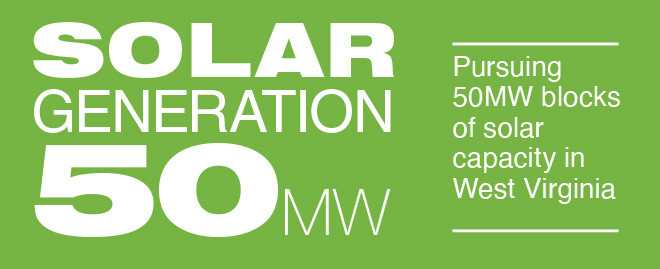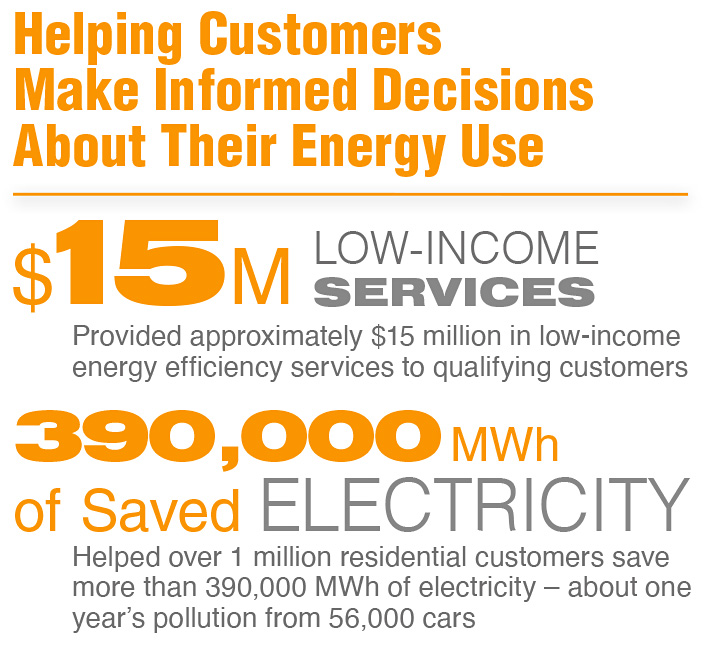OUR APPROACH
As part of our Climate Strategy and company strategy, we're focused on our role in enabling the energy transition to a low-carbon future and supporting our customers' evolving needs along the way. That includes anticipating and responding to customer expectations for reliable service, clean energy sources, increased control over their energy use and carbon footprint, as well as more sustainable alternatives in transportation, manufacturing and industrial processes. Among other efforts discussed below, our strategic transmission and distribution investments are key to creating a reliable, resilient and secure grid, and enabling the clean energy transition for the customers we serve.
TRANSMISSION INVESTMENTS FOR A CLEAN ENERGY FUTURE
Our transmission investments are key to reliably integrating more renewables and distributed energy resources into our region's electric grid – and enabling the carbon-neutral future our customers and communities want. We're preparing for that future by:
- Investing in upgrades that ready grid operators to respond more swiftly to changing conditions and facilitate the reliable inclusion of smaller, distributed generating sources.
- Assessing the value of energy storage as a transmission asset to enable greater operational flexibility, increased protection against physical asset risks, and better support for increased renewables and distributed energy resources.
- Upgrading and modernizing our transmission system to provide customers with a stronger, smarter and more secure power grid for years to come.
Please see our Energy Reliability page and Investor Factbook for more information on our transmission investments.
SUPPORTING CLEAN ENERGY OPTIONS
FirstEnergy is taking many steps to prepare for a reduced carbon world, and each state where we operate presents a different path toward the clean energy future. Though regulatory decisions may limit our ability to develop renewable generation, we recognize that our customers expect more sustainable energy options and are exploring ways to meet that demand across our service territory.
Five of the six states in which FirstEnergy principally operates (Ohio, Pennsylvania, New Jersey, Maryland and New York) are deregulated states. With a few exceptions, FirstEnergy's utilities are prohibited from owning generation in these states. This includes renewable generation assets such as solar and wind, as well as energy storage when storage is defined as a generation asset.
We want to empower our customers with solutions that meet their energy needs and reduce the region's carbon footprint. Working within the bounds of state laws and regulations, we are continually looking for and acting on opportunities to build the clean energy future we all envision.
In 2020, FirstEnergy set a goal to own at least 50 MW of solar energy in West Virginia. Since then, our Mon Power and Potomac Edison utilities have received conditional approval from the Public Service Commission of West Virginia (WVPSC) for five utility-scale solar facilities, which will together total 50 MW of renewable generation. The utilities' solar program aligns with a 2020 bill passed by the West Virginia legislature that authorizes electric utilities to own and operate up to 200 MW of solar generation facilities to help meet the state's electricity needs.

In October 2022, the New Jersey Board of Public Utilities (BPU) selected JCP&L, in a joint proposal with Mid-Atlantic Offshore Development, LLC (MAOD), to build new and upgrade existing transmission infrastructure to connect clean energy generated by New Jersey's offshore wind farms to the power grid. The nearly $723 million investment minimizes environmental and community impacts by using existing rights of way and avoiding greenfield development. Construction is expected to begin in 2025, with completion targeted by 2030, supporting New Jersey's goal of introducing 7500 MW of offshore wind-generated electricity by 2035.
INTEGRATING DISTRIBUTED ENERGY RESOURCES
We understand the pressing desire for low- and zero-carbon generation and recognize that our customers expect more sustainable energy options. We support our customers' right to safely use distributed energy resources (DERs) and have developed processes that support the interconnection of solar, energy storage and other DERs consistent with the laws and regulations of the states in which we operate.

As customers grow more interested in the opportunities presented by distributed energy resources, we are studying the best ways to facilitate connection to our grid. Every installation is unique, and we work closely with customers who submit an application to interconnect their DERs with our distribution system. We have developed a comprehensive review process to assess the interconnection scenario, request clarifications and identify any adjustments needed before proceeding with the interconnection process. Once these requirements are satisfied, we collaborate with customers to complete the safe and reliable integration of their DER project on our grid.
As we explore ways to meet our customers' increasing demand for use DERs, we must also maintain compliance with regulatory restrictions related to renewable energy generation. For example, FERC Order 2222 opens up wholesale market participation to aggregation of distributed energy resources on the distribution system. To help clarify the full scope and implications of such regulations, we have a dedicated team focused on understanding how all those individual DER components, when aggregated, can be effectively and safely integrated into our system.
EXPANDING ELECTRIC VEHICLE (EV) INFRASTRUCTURE
We view electrification as an opportunity to significantly reduce our region's carbon footprint. Our long-term vision is to help lead a seamless and reliable economywide electrification effort and power a more sustainable future for the customers and communities we serve.
Transportation electrification has the potential to eliminate direct tailpipe emissions from gasoline-powered cars and improve air quality across our service area. Our EV Driven programs in Maryland and New Jersey are making electric vehicle adoption more accessible, convenient and affordable.

In Maryland, we're supporting the state's goal to have 300,000 zero-emission vehicles on the road by 2025. Through our EV Driven program, Potomac Edison is installing utility-owned public charging stations throughout its Maryland service area. Through August 1, 2022, we have installed 22 charging stations as well as eight direct-current (DC) fast chargers, which can provide an 80% charge for most EVs in less than an hour. We have also installed Level 2 charging stations that accommodate two vehicles simultaneously and deliver 8 to 24 miles of range per hour of charging.
In New Jersey, we're supporting the state's goal of registering 330,000 electric vehicles by 2025 by providing incentives for electric vehicle charging infrastructure through JCP&L's new EV Driven program. The four-year, $38.9 million program includes three components:
- Residential charging– provides up to $1,500 in incentives for customer electrical upgrades necessary for the installation of up to 2,000 qualified Level 2 electric vehicle chargers in JCP&L's service area.
- Mixed-use commercial and multifamily property charging – provides up to $6,700 per qualified Level 2 charger for up to 500 public-access ports, and up to $5,000 per port for a maximum of 100 ports dedicated to workplace use across JCP&L's service territory.
- Public-access DC Fast charging – provides up to $25,000 per DC fast charger port for up to 248 charging locations accessible to the public across JCP&L's service territory.
To learn more about how FirstEnergy is supporting state efforts to reduce emissions by expanding EV charging infrastructure, visit our New Jersey EV Driven website.
As EV purchases continue to increase, drivers will need to know that EV charging infrastructure is in place to support their needs – especially for long-distance and interstate travel. We strive to be an industry leader and believe it's important for FirstEnergy to participate in larger conversations surrounding widespread electrification. For example, we participate in the Electric Highway Coalition, a group of electric companies committed to enabling long-distance EV travel through a network of fast-charging stations connecting major highway systems. By working together towards efficient and effective fast-charging deployment plans, we avoid duplication of efforts among coalition utilities and complement existing fast-charging sites.
DRIVING ENERGY EFFICIENCY
FirstEnergy has long supported our customers' ability to use energy more efficiently and wisely. Our energy efficiency programs are one way we help customers identify areas to reduce energy use and minimize their carbon footprint while also saving money on their electricity bills.

Energy efficiency and/or peak demand reduction policies, including annual incremental energy efficiency targets of up to 2% of total customers' usage, have been established in certain states to meet long-term customer and community sustainability needs. We offer a suite of energy efficiency programs to meet or exceed these reduction targets while also supporting system reliability and lowering customers' demand for electricity.
Residential customers can save energy through significant incentives that offset the costs of major home efficiency upgrades, such as home insulation and weatherization, major appliance upgrades or heating and cooling system improvements. Others may benefit from smaller, incremental changes such as lighting improvements, enhanced energy usage data and education, or kits that provide useful energy-efficient products, such as LED light bulbs.
We also offer solutions for small businesses, government entities, schools and even the largest and most energy-intensive manufacturers and industries. Our portfolio of commercial and industrial programs provides measures and financial incentives for these customers to purchase qualifying high-efficiency products; recycle inefficient appliances; complete energy audits; and adopt energy-saving behaviors or energy management practices.
To view these and other programs available to our residential, commercial and industrial customers, visit our Save Energy website.
Please also see our EESG data table for our energy efficiency metrics.
